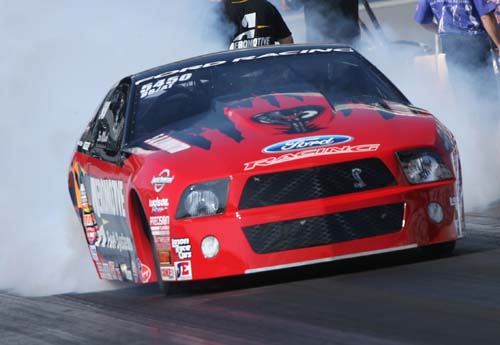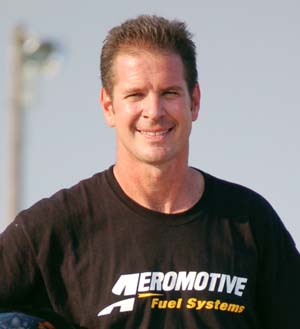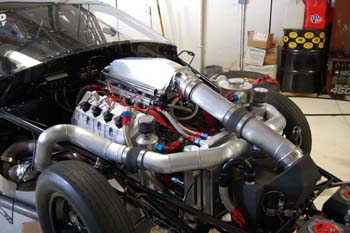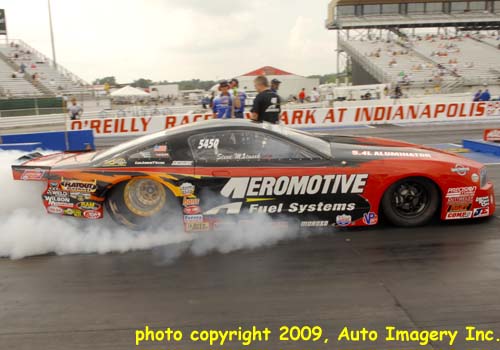A REAL PRO STOCKER?
 If you’ve ever wondered what a true Pro Stocker should like, sound like, run like; the kind utilizing the same technology you can
watch race on Sunday and then buy on Monday, Steve Matusek has just the
treat for you, with a minor exception. Drag racing hasn’t caught up to
the technology Matusek has created with his modular-powered, 2007
Shelby GT 500.
If you’ve ever wondered what a true Pro Stocker should like, sound like, run like; the kind utilizing the same technology you can
watch race on Sunday and then buy on Monday, Steve Matusek has just the
treat for you, with a minor exception. Drag racing hasn’t caught up to
the technology Matusek has created with his modular-powered, 2007
Shelby GT 500. “Making it resemble today’s current technology was the game plan from the moment we began building the car,” Matusek said. “We wanted to build a car that the average person in the grandstands could relate to.
“We wanted to make a splash and relate to the fans. We honestly wanted to build something they could buy on Monday at their local dealership.
If Pro Stock was Based On Available Detroit Technology, This Shelby G.T. 500 Would Be Just Another Car …

If you’ve ever wondered what a true Pro Stocker should like, sound like, run like; the kind utilizing the same technology you  can watch race on Sunday and then buy on Monday, Steve Matusek has just the treat for you, with a minor exception. Drag racing hasn’t caught up to the technology Matusek has created with his modular-powered, 2007 Shelby GT 500.
can watch race on Sunday and then buy on Monday, Steve Matusek has just the treat for you, with a minor exception. Drag racing hasn’t caught up to the technology Matusek has created with his modular-powered, 2007 Shelby GT 500.
“Making it resemble today’s current technology was the game plan from the moment we began building the car,” Matusek said. “We wanted to build a car that the average person in the grandstands could relate to.
“We wanted to make a splash and relate to the fans. We honestly wanted to build something they could buy on Monday at their local dealership.
The move in today’s sponsorship-strapped drag racing world continually yields positives for Matusek, who admits a healthy involvement from Ford Motorsports on the ever-evolving project.
Everything on the car illustrates cutting edge technology, from its destroked 323-inch modular motor to the stand-alone, fully programmable F.A.S.T. electronic fuel injection system to the pair of Kenny Duttweiler-massaged Precision Turbo turbochargers has the media clamoring to get the inside story on the car. Then there are the details that he doesn’t reveal. That’s another story in itself.
“I think a lot of guys racing and even the manufacturers, lost sight of what their goals were,” Matusek admitted. “The objective was always to have a car that looked familiar to the average person, that they could walk up to and look at your name and brand and develop a familiarity.”
a d v e r t i s e m e n t
Click to visit our sponsor's website
The rhyme behind the reason for Matusek was to likewise build a car that would be tied to his Aeromotive fuel system products. Matusek, the President of Aeromotive, Inc., believes the popularity of the car can have a correlation with the products his company manufactures.
Case in point, he’s got the ultimate test vehicle with the end result applied to products he crafts for both street and strip applications.
“Funny you should mention that, we just happened to have a line of products with street applications,” Matusek said with a smile. “We have a lot of products that are bolt-on and reach well beyond Ford applications. Our range encompasses everything from the LS market to Sport Compacts. We have Mitsubishi and Subaru applications as well.
“Race fans can look at our car and know they can buy a similar street version. When you find that person with a similar street version, more times than not, they draw the parallel that the same high performance parts on our car are the same ones they can buy for their street machine. Drag racing still sells street parts. Just like in the old days, the performance is the endorsement.”
Beyond the business-to-consumer projections, the popularity of Matusek’s 6.4-second creation has created unique opportunities in the business-to-business realm. Reportedly, Matusek has been in talks with Ford to supply Aeromotive fuel systems on the 2010 Cobra Jet Mustangs.
“We have had dialogue with Ford in the off-season,” Matusek revealed. “We were just trying to formulate our next step in the project. Ford was involved in the development of the nitromethane engine but they didn’t have a huge interest in selling that engine. The engine we have creates a different kind of marketing tool.”
a d v e r t i s e m e n t
Click to visit our sponsor's website
 Matusek’s 323-incher carries factory appeal and it doesn’t matter whether he’s running as a BB/Altered Turbocharged entry in NHRA’s Comp eliminator or entered as an underdog Pro Modified, the manufacturer prefers he keeps the current engine combination between the fenders.
Matusek’s 323-incher carries factory appeal and it doesn’t matter whether he’s running as a BB/Altered Turbocharged entry in NHRA’s Comp eliminator or entered as an underdog Pro Modified, the manufacturer prefers he keeps the current engine combination between the fenders.
“They want us to keep this combination together because this is the powerplant they will use for the near future,” Matusek conveyed. “To have us out there learning about it, pushing it and promoting the engine and having virtually an OEM block and heads, capable of competing against the craziest of the aftermarket is a real feather in the their caps.”
Matusek told CompetitionPlus.com that Brian Wolfe, Director of Ford Racing Technology, has been a fan of the car for some time, predating his days of holding his corporate leadership role.
“Early on – when a lot of people had written us off as crazy for undertaking this project, Brian and Jesse Kershaw stood behind us,” Matusek said. “They haven’t wavered in their support now that he’s in a position of power.”
If there’s one area that strays away from the traditionalism it’s the choice of power adder. Matusek felt the turbocharged combination provided the best opportunity to showcase the Shelby G.T. 500 as opposed to using a standard under-the-hood roots-style supercharger which can be purchased from the factory.
The fact this combination will adapt to a turbocharger for street applications made the transition a natural one. Could this also provide the impetus for a future turbocharged package?
“The cost and efficiency of this combination played a large factor in my decision to go this route,” Matusek explained.
When you hear Matusek’s turbo run, it doesn’t sound like your average large displacement turbo car, cracking and popping like a Saturday night in south central Los Angeles. Matusek’s Shelby G.T. 500 sounds much more subdued in the spooling process to create boost, although it wasn’t always that way.
a d v e r t i s e m e n t
Click to visit our sponsor's website
 Matusek says the jury is out as to whether this procedure actually aids the car in bringing the power level up because he has experienced some parts attrition along the way including broken headers.
Matusek says the jury is out as to whether this procedure actually aids the car in bringing the power level up because he has experienced some parts attrition along the way including broken headers.
“You put the car on the two step and those explosions in the pipes creates energy which excites the turbo,” Matusek explained. “If you’re a novice driver and not accustomed to the process, it will get the best of you in the cockpit. I think my first time I ended up giving a stool, urine and sperm sample all in one run.”
A large factor in the reason his spooling process sounds more subdued lies greatly in the smaller displacement. This was a trait of the legendary Buddy Ingersoll, who made turbocharging hip in the 1970s and 1980s. To this date, Matusek draws inspiration from Ingersoll’s attempt to run Pro Stock in 1986 with a twin-turbo, 260-inch Buick.
Matusek has deemed Ingersoll as the standard in which all turbocharged applications should be based on.
“Buddy was way ahead of his time,” Matusek said. “He was successful with a lot less tools than we have at our disposal. He didn’t have a lot of the electronics. He was a true pioneer. I owe him a call because I really want to learn from him to see if there’s a better way to refine our project.”
Just like Ingersoll was back in the day, Matusek would love nothing more than to get the chance to have his present combination considered for inclusion in Pro Stock. A complete transformation would be even better.
“I think it would be nearly impossible for a successful lobby because we just don’t carry the same clout,” Matusek said. “Plus a lot of teams have a great deal of money invested in the 500-inch programs. But, I will state on the record, right here, if the NHRA would at least consider (the possibility), we’d be more than happy to share our blueprint with the teams to help them find a baseline. That’s how bad we want to be considered.”
With a best elapsed time of 6.47 seconds at 222 miles per hour, will the NHRA be open to reinventing Pro Stock to modern technology?
Matusek sure hopes so.
| {loadposition feedback} |






































